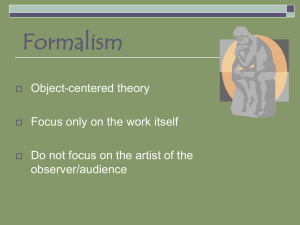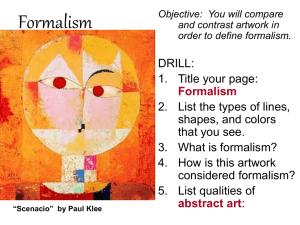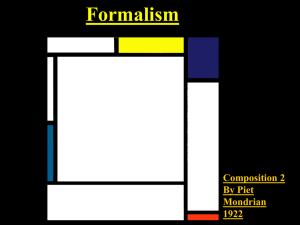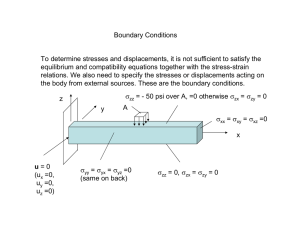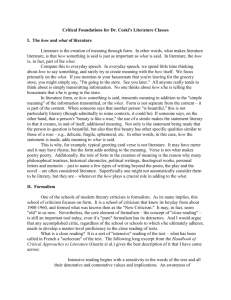Application of the Trefftz method, on the basis of Stroh... to solve the inverse Cauchy problems of anisotropic elasticity
advertisement
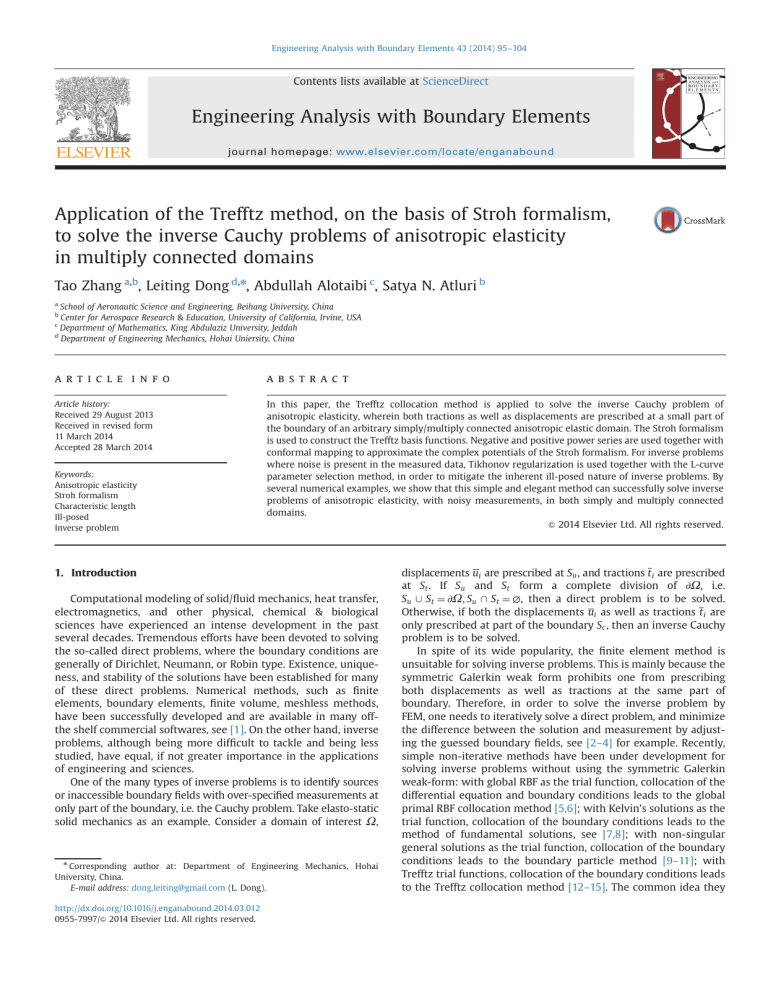
Engineering Analysis with Boundary Elements 43 (2014) 95–104 Contents lists available at ScienceDirect Engineering Analysis with Boundary Elements journal homepage: www.elsevier.com/locate/enganabound Application of the Trefftz method, on the basis of Stroh formalism, to solve the inverse Cauchy problems of anisotropic elasticity in multiply connected domains Tao Zhang a,b, Leiting Dong d,n, Abdullah Alotaibi c, Satya N. Atluri b a School of Aeronautic Science and Engineering, Beihang University, China Center for Aerospace Research & Education, University of California, Irvine, USA c Department of Mathematics, King Abdulaziz University, Jeddah d Department of Engineering Mechanics, Hohai Uniersity, China b art ic l e i nf o a b s t r a c t Article history: Received 29 August 2013 Received in revised form 11 March 2014 Accepted 28 March 2014 In this paper, the Trefftz collocation method is applied to solve the inverse Cauchy problem of anisotropic elasticity, wherein both tractions as well as displacements are prescribed at a small part of the boundary of an arbitrary simply/multiply connected anisotropic elastic domain. The Stroh formalism is used to construct the Trefftz basis functions. Negative and positive power series are used together with conformal mapping to approximate the complex potentials of the Stroh formalism. For inverse problems where noise is present in the measured data, Tikhonov regularization is used together with the L-curve parameter selection method, in order to mitigate the inherent ill-posed nature of inverse problems. By several numerical examples, we show that this simple and elegant method can successfully solve inverse problems of anisotropic elasticity, with noisy measurements, in both simply and multiply connected domains. & 2014 Elsevier Ltd. All rights reserved. Keywords: Anisotropic elasticity Stroh formalism Characteristic length Ill-posed Inverse problem 1. Introduction Computational modeling of solid/fluid mechanics, heat transfer, electromagnetics, and other physical, chemical & biological sciences have experienced an intense development in the past several decades. Tremendous efforts have been devoted to solving the so-called direct problems, where the boundary conditions are generally of Dirichlet, Neumann, or Robin type. Existence, uniqueness, and stability of the solutions have been established for many of these direct problems. Numerical methods, such as finite elements, boundary elements, finite volume, meshless methods, have been successfully developed and are available in many offthe shelf commercial softwares, see [1]. On the other hand, inverse problems, although being more difficult to tackle and being less studied, have equal, if not greater importance in the applications of engineering and sciences. One of the many types of inverse problems is to identify sources or inaccessible boundary fields with over-specified measurements at only part of the boundary, i.e. the Cauchy problem. Take elasto-static solid mechanics as an example. Consider a domain of interest Ω, n Corresponding author at: Department of Engineering Mechanics, Hohai University, China. E-mail address: dong.leiting@gmail.com (L. Dong). http://dx.doi.org/10.1016/j.enganabound.2014.03.012 0955-7997/& 2014 Elsevier Ltd. All rights reserved. displacements ui are prescribed at Su , and tractions t i are prescribed at St . If Su and St form a complete division of ∂Ω, i.e. Su [ St ¼ ∂Ω; Su \ St ¼ ∅, then a direct problem is to be solved. Otherwise, if both the displacements ui as well as tractions t i are only prescribed at part of the boundary Sc , then an inverse Cauchy problem is to be solved. In spite of its wide popularity, the finite element method is unsuitable for solving inverse problems. This is mainly because the symmetric Galerkin weak form prohibits one from prescribing both displacements as well as tractions at the same part of boundary. Therefore, in order to solve the inverse problem by FEM, one needs to iteratively solve a direct problem, and minimize the difference between the solution and measurement by adjusting the guessed boundary fields, see [2–4] for example. Recently, simple non-iterative methods have been under development for solving inverse problems without using the symmetric Galerkin weak-form: with global RBF as the trial function, collocation of the differential equation and boundary conditions leads to the global primal RBF collocation method [5,6]; with Kelvin’s solutions as the trial function, collocation of the boundary conditions leads to the method of fundamental solutions, see [7,8]; with non-singular general solutions as the trial function, collocation of the boundary conditions leads to the boundary particle method [9–11]; with Trefftz trial functions, collocation of the boundary conditions leads to the Trefftz collocation method [12–15]. The common idea they 96 T. Zhang et al. / Engineering Analysis with Boundary Elements 43 (2014) 95–104 share is that the collocation method is used to satisfy either the differential equations and/or the boundary conditions at discrete points. Collocation method is one of the most simple, efficient, and flexible methods, which allow both the tractions and displacements to be prescribed at the same location. Moreover, collocation method is also more suitable for inverse problems because measurements are most often made at discrete locations. Among the various methods, the Trefftz method has shown extremely high efficiency and accuracy, provided that a relative complete trial function is used [14–18]. For a two-dimensional problem such as 2D Laplace equations and linear elasticity, the general solutions can mostly be expressed as analytic functions of complex variables. The completeness of the Trefftz trial functions therefore solely depends on how an analytic function should be approximated in a complex plane. Based on a detailed discussion in [14], a generalized Trefftz method is proposed to solve twodimensional isotropic linear elasticity with arbitrarily shaped multiply connected domains. The later successful application of it in the direct numerical solution (DNS) of heterogeneous materials considering a large number of voids or inclusions [18–21], also demonstrated the ability of generalized Trefftz method in solving problems of 2D and 3D multiply connected domains. In this paper, we combine and follow the work of [14] and [22–24] to apply the Trefftz method on the basis of Stroh Formalism to solve inverse problems of anisotropic elasticity, which was firstly dealt with in [25], in multiply connected domains. In Section 2, we introduce the Stroh formalism for two-dimensional anisotropic elasticity, with special attention being paid to how complex potentials f α ðzα Þ should be selected to construct the Trefftz trial functions. In Section 3, we give the detailed algorithm of Trefftz collocation method for inverse problems of anisotropic elasticity. Specifically, a simple regularization algorithm is given to increase the robustness of the algorithm when noise is considered. After that, several numerical examples are given in Section 4, to study the accuracy, convergence, and robustness of the proposed method. At last, some concluding remarks are made in Section 5. This leads to the Navier’s equations with displacements as primary variables, for a homogenous elastic body: C ijkl uk;li þ f j ¼ 0 ð2Þ Here C ijkl are the components of the fourth-order elasticity tensor for a homogenous solid. For plane problems where body forces are negligible, the general solution of the Navier’s equation (2) can be expressed through the Stroh Formalism. According to Ting’s monograph [24], we have 4 u ¼ ∑ aα f α ðzα Þ ð3Þ zα ¼ x1 þ pα x2 ð4Þ q¼1 f α ðzα Þ is an arbitrary analytic functions of zα , and pα and aα are the eigenvalues and eigenvectors of the following eigen-equation: fQ þpðR þ RT Þ þ p2 T ga ¼ 0 which is equivalent to " T1 T 1 RT RT 1 T R Q ðT 1 ð5Þ # a T T R Þ b Considering a linear elastic solid undergoing infinitesimal elasto-static deformations, the equations of linear and angular momentum balance, constitutive equations, and compatibility equations can be written as sij;i þ f j ¼ 0; sij ¼ sji 1 2 εij ¼ ðui;j þuj;i Þ uði;jÞ b Q ik ¼ C i1k1 ; Rik ¼ C i1k2 ; T ik ¼ C i2k2 ð6Þ ð7Þ Eq. (5) will give two pairs of conjugate solutions: pα þ 2 ¼ pα ; aα þ 2 ¼ aα ; bα þ 2 ¼ bα ; α ¼ 1; 2 ð8Þ Letting f α þ 2 ¼ f α , then Eq. (3) can be re-written as 2 u ¼ 2Re ∑ aα f α ðzα Þ α¼1 ð9Þ And corresponding stresses can be expressed as si1 ¼ Φi;2 ; si2 ¼ Φi;1 2 Φ ¼ 2Re ∑ bα f α ðzα Þ ð10Þ Now that general expressions for displacements and tractions have been worked out, the main issue is how the function f α ðzα Þ should be approximated for numerical implementation. According to [13], when a simply connected domain is considered, it is reasonable to express the complex potentials with positive power series, representing modes of tension, shear, bending, etc.: N f α ðzα Þ ¼ ∑ ðiAnαo þ Bnαo Þðzα zoα Þn : sij ¼ C ijkl εkl a For plane elasticity, Q, R, T are 2 by 2 real matrices given by α¼1 2. Stroh formalism for anisotropic elasticity ¼p ð11Þ n¼0 ð1Þ where the Einstein summation convention on repeated indices is used. where zoα ¼ x1 þ pα x2 with ðx1 ; x2 Þ being the source point placed inside the domain. For a doubly connected domain, we can locate the source point inside the cavity, and apply conformal mapping from zα plane to Fig. 1. Conformal mapping from an ellipse to a unit circle. T. Zhang et al. / Engineering Analysis with Boundary Elements 43 (2014) 95–104 97 ξα plane, where the cavity is mapped to a unit circle. For example, This regularization technique is applied to many FEM and BEMbased methods, which leads to the regularized solution: 1 α ¼ AT A þ γ I AT b ð21Þ zα zcα ¼ ωcα ðζ α Þ ¼ a 2ipα bζ α þ a þ2ipα b ζ1c α qffiffiffiffiffiffiffiffiffiffiffiffiffiffiffiffiffiffiffiffiffiffiffiffiffiffiffiffiffiffiffiffiffiffiffiffiffiffiffiffiffiffiffiffi 2 c ðzα zα Þ 7 ðzα zcα Þ2 a2 p2α b : ζ cα ¼ ωcα 1 ðzα zcα Þ ¼ a ipα b c c c z α ¼ x 1 þ pα x 2 In this paper, Tikhonov Regularization is combined with the L-curve method to enhance the robustness of the solution by Trefftz method. The regularization parameter γ is determined by the corner of the L-curve, which is the plot of the norm of residual with respect to the norm of the solution vector. Detailed demonstration of the L-curve method is given in Case 4 of the numerical examples presented in the next section. if an elliptical cavity c0 is considered with semi-axes a and b, and center ðxc1 ; xc2 Þ, see Fig. 1, the conformal mapping can be constructed as c c ð12Þ And the complex potentials are expressed as f α ðzα Þ ¼ N ∑ ðiAnαc þ Bnαc Þξα : c ð13Þ n ¼ M 4. Numerical examples Furthermore, if multiple cavities are considered with centers ðxc1 ; xc2 Þ; c ¼ 1; 2; …; K, the complex potentials can be represented as N K f α ðzα Þ ¼ ∑ ðiAnαo þ Bnαo Þðzα zoα Þn þ ∑ N ∑ ðiAnαc þ Anαc Þξα c ð14Þ c ¼ 1 n ¼ M n¼0 However, it should be noted that, the exponential growth of Trefftz basis functions as given in (11)–(14) will commonly give an illconditioned system of equations. This can be easily resolved by introducing a characteristic length to scale the Trefftz basis functions, see [14] for a detailed discussion. 3. Trefftz collocation method for inverse problems with regularization uðx1 ; x2 Þ ¼ Nðx1 ; x2 Þα rðx1 ; x2 Þ ¼ Sðx1 ; x2 Þα tðx1 ; x2 Þ ¼ Rðx1 ; x2 Þα ¼ nSðx1 ; x2 Þα ð15Þ at SC ð16Þ at SC We collocate the displacements and tractions at points P k : ðxk1 ; xk2 Þ A SC ; k ¼ 1; 2; …, Ni ðxk1 ; xk2 Þα ¼ ui ðxk1 ; xk2 Þ; k ¼ 1; 2:::: wR i ðxk1 ; xk2 Þα ¼ wt i ðxk1 ; xk2 Þ; k ¼ 1; 2…; ð17Þ ð18Þ where w is a parameter to make the coefficient matrices of Eqs. (17) and (18) to have the same norm. The resulting systems of equations can be rewritten in matrix/vector form: Aα ¼ b In the first case, a beam-shaped simply connected domain is considered, which can be described by Ω ¼ ðx1 ; x2 Þj0 r x1 r L; c r x2 r cg. As shown in Fig. 2, the geometrical parameters are L¼ 24, c ¼ 2. Arbitrarily we consider the elastic stiffness 2 3 2 3 C 11 C 12 C 16 3:0638 0:2553 0 6C 7 6 7 0 5. And the matrix C ¼ 4 21 C 22 C 26 5 ¼ 4 0:2553 1:0213 C 62 C 66 0 0 0:43 compliance matrix is determined by A ¼ C 1 . The analytical solution of a cantilever beam subjected to shear load at the free end is considered, which is given by Lekhnitskii in [28]: 2 2 2 u1 ¼ Px 6I ð3x1 a11 ð2L x1 Þ þ ða12 a66 Þðx2 c ÞÞ where n represents the unit normal vector at the boundary. For the inverse Cauchy problem we are considering in this study, the displacements as well as tractions are prescribed at only a small portion of the boundary: nj sij ¼ t i Case 1. Cantilever beam C 61 With the detailed algorithm of constructing Trefftz basis functions, we can represent the trial functions as ui ¼ ui In this section, we use some numerical examples to demonstrate the effectiveness of the proposed method. All the numerical examples are conducted with MATLAB on a PC with i7 processor. P ð 3a12 x22 ðL x1 Þ ð2a66 a12 Þc2 x1 þa11 x21 ð3L x1 ÞÞ 6I Px P s11 ¼ 2 ðL x1 Þ; s22 ¼ 0; s12 ¼ ðc2 x22 Þ 2I I u2 ¼ ð22Þ So we raise a problem like this: can we identify the displacements, strains, and stresses in the whole domain, if both the displacements and the tractions at only a small portion of the boundary are measured (over-specified)? We solve this problem by using the Trefftz method of Stroh formalism with Positive power series truncated at the order of 3. The displacement and tractions are measured at the 10 red circles as shown in Fig. 2, which are uniformly distributed at the lower edge SC ¼ ðx1 ; x2 Þj16 r x1 r 24; x2 ¼ 2 . Collocations of displacements and tractions are made at the locations of measurements. The identified stress component s11 and vertical displacement v on the lower edge Sd of the cantilever beam by Tefftz method are plotted in Fig. 3 (normalized to their maximum values). The computed results agree perfectly with the analytical solution. ð19Þ It is well known that the inverse problems are ill-posed. A very small perturbation of the measurement data can lead to a significant change of the solution. In order to mitigate the illposedness of the inverse problem, regularization techniques can be used. For example, following the work of Tikhonov [26], many regularization techniques were developed. Hansen et al. [27] have given an explanation that the Tikhonov regularization of ill-posed linear algebra equations is a trade-off between the size of the regularized solution, and the quality to fit the given data. With a positive regularization parameter γ , the solution is found by min jjAαbjj22 þ γ jjαjj22 ð20Þ Fig. 2. The problem of a cantilever beam under a shear load at the free end and the adopted collocation points. (For interpretation of the references to color in this figure caption, the reader is referred to the web version of this paper.) 98 T. Zhang et al. / Engineering Analysis with Boundary Elements 43 (2014) 95–104 cantilever beam 1 0.9 0.8 Analytical STROH FORMALISM Normalized σ11 0.7 0.6 0.5 0.4 0.3 0.2 Fig. 4. A plate with a circular hole under uniform tension. (For interpretation of the references to color in this figure caption, the reader is referred to the web version of this paper.) 0.1 0 0 0.2 0.4 0.6 0.8 1 X1 Case 3. a plate with an elliptical hole cantilever beam In this example, a doubly connected domain is considered. n o 2 2 As shown in Fig. 7,Ω ¼ ðx1 ; x2 Þ c r x1 ; x2 r c; xa1 þ xb2 r 1 1 0.9 is defined by one elliptical hole in a 20 by 20 square plate under uniform tension P, where c ¼ 10 and P ¼ 1. Arbitrarily 2 3 C 11 C 12 C 16 6 7 we consider the stiffness matrix C ¼ 4 C 21 C 22 C 26 5 ¼ C 61 C 62 C 66 2 3 1:2030 0:0427 0 6 0:0427 0:6015 0 7 4 5. And three different ratios of semi0 0 0:07 axes of the ellipse are used here for demonstration: Normalized Displacement v 0.8 0.7 0.6 0.5 0.4 0.3 a ¼ 2b ¼ c=3 ðor c=10; c=20Þ: 0.2 Analytical STROH FORMALISM 0.1 0 0.2 0.4 0.6 0.8 1 X1 Fig. 3. Comparison of the normalized identified stress component s11 and vertical displacement v at the lower edge Sd of the cantilever beam, Sd ¼ fðx1 ; x1 Þj0 r x1 r 24; x2 ¼ 2g. Case 2. a plate with a circular hole As shown in Fig. 4, we also consider a doubly connected domain, qffiffiffiffiffiffiffiffiffiffiffiffiffiffi n o x21 þ x22 r R . R ¼1 denotes the Ω ¼ ðx1 ; x2 Þj 10 rx1 ; x2 r 10; radius of the hole. Arbitrarily we consider the elastic stiffness 2 3 2 3 C 11 C 12 C 16 1:2030 0:0427 0 6C 7 6 0 7 C ¼ 4 21 C 22 C 26 5 ¼ 4 0:0427 0:06015 5. The analytical C 61 C 62 C 66 0 0 0:07 solution of an infinite plate with a circular hole under uniform tension, given by [28], is used here. We collocate both the displacements and tractions at 10 points uniformly distributed at part of the lower edge, i.e. SC ¼ fðx1 ; x2 Þj 10 r x1 r 6; x2 ¼ 10g. The collocation points are shown as red circles in Fig. 4. After solving this inverse Cauchy problem with Trefftz method, we plot the stress components s11 , s22 and horizontal displacement u at the positive x1 -axis, and we plot the stress components s11 , s22 and vertical displacement v at the positive x2 -axis. As we can see from Figs. 5 and 6, the computed results agree well with the analytical solutions. The analytical solution of an infinite plate with an elliptical hole under uniform tension by Lekhnitskii’s work in [28] is used here as the solution to be sought for. We measure the displacements and tractions at 10 points, shown as red circles in the Fig. 7, at the same locations as those of case 2, i.e. SC ¼ fðx1 ; x2 Þj 10 r x1 r 6; x2 ¼ 10g. We solve this problem by using the Trefftz method with Stroh formalism as trial functions. Positive power series complete to the order of 2 is used with negative power series complete to the order of 1. We plot the stress components s11 , s22 and horizontal displacement u along the positive x2 -axis. And we plot stress components s11 , s22 and vertical displacement v along the positive x2 -axis. As can be seen in Figs. 8, 9 and 10, good agreements can be found with analytical solutions. Case 4. a plate with an elliptical hole with different level of white noise In this case, we consider a 20 by 20 anisotropic square plate n 2 with an elliptical hole Ω ¼ ðx1 ; x2 Þ 10 r x1 ; x2 r10; xa1 þ o x 2 2 r 1 , subject to uniform tension P. Geometrical parameters b a ¼ 6; b ¼ 5 are considered in this case. Arbitrarily we take the same stiffness matrix C as that for case 3. The analytical solution of a plate with an elliptical hole under uniform tension can be found by Lekhnitskii’s work in [28], and we use it here as the solution to be sought for. When dealing with inverse problems, usually the measured data is perturbed by noise and the solutions are unstable due to the ill-posedness of inverse problems. Thus, through case 4, we investigate properly the following important features of the proposed method. T. Zhang et al. / Engineering Analysis with Boundary Elements 43 (2014) 95–104 99 R=1 R=1 0.9 5.5 0.8 5 0.7 4.5 4 Analytical Stroh Formalism 0.5 σ11 σ11 0.6 0.4 3.5 3 0.3 2.5 0.2 2 0.1 1.5 0 Analytical Stroh Formalism 1 2 3 4 5 6 7 8 9 1 10 1 2 3 4 5 X1 R=1 7 8 9 10 R=1 0.1 0.2 0 0.18 −0.1 0.16 Analytical Stroh Formalism Analytical Stroh Formalism 0.14 −0.2 0.12 −0.3 σ22 σ22 6 X2 −0.4 0.1 0.08 −0.5 0.06 −0.6 0.04 −0.7 −0.8 0.02 1 2 3 4 5 6 7 8 9 0 10 1 2 3 4 5 X1 6 7 8 9 10 X2 R=1 R=1 9.5 −0.7 9 −0.8 8.5 Displacement v Displacement u 8 7.5 7 6.5 Analytical Stroh Formalism −1 −1.1 6 5.5 −1.2 Analytical Stroh Formalism 5 4.5 −0.9 1 2 3 4 5 6 7 8 9 10 X1 −1.3 1 2 3 4 5 6 7 8 9 10 X2 Fig. 5. Comparison of the identified stress components s11 , s22 and the horizontal displacement u at the positive x1 -axis for the plate with circular hole. Fig. 6. Comparison of the identified stress component s11 , s22 and the vertical displacement v at the positive x2 -axis for the plate with circular hole. 4.1. Influence of noisy measurements Both displacements and tractions are measured at 10 uniformly distributed points at two edges: fðx1 ; x2 Þj 10 r x1 r2; x2 ¼ 10g and fðx1 ; x2 Þjx1 ¼ 10; 2 r x2 r 10g: For this problem, the truncation number for the Trefftz basis functions is 10. We analyze the Various levels (pu and pt ) of white noise are added into the measured displacements and tractions, respectively. 100 T. Zhang et al. / Engineering Analysis with Boundary Elements 43 (2014) 95–104 a=c/20 1 0.9 0.8 Analytical Stroh Formalism 0.7 σ11 0.6 0.5 0.4 0.3 0.2 Fig. 7. a plate with an elliptical hole under uniform tension. (For interpretation of the references to color in this figure caption, the reader is referred to the web version of this paper.) 0.1 0 0 2 4 6 8 10 X1 1 a=c/20 0.9 a=c/20 0.1 0.8 0 0.7 a=c/10 −0.1 Analytical Stroh Formalism −0.2 0.5 a=c/3 0.4 σ22 σ11 0.6 −0.3 −0.4 0.3 Analytical Stroh Formalism 0.2 −0.5 0.1 −0.6 0 0 2 4 6 8 −0.7 10 X1 −0.8 Fig. 8. Comparison of the identified stress component s11 at the positive x1 -axis with different sizes of the elliptical hole. 0 2 4 6 8 10 X1 a=c/20 4.2. Influence of number of collocation points In order to find out the effect of the number of collocation points, we consider three different collocation schemes. In the following three cases, measurements and collocations are uniformly distributed at nc ¼ 3, 10, and 80 points on each of the two sides ðx1 ; x2 Þj0 r x1 r 2;x2 ¼ 10 and ðx1 ; x2 Þjx1 ¼ 10; 2 r 9 8 7 Displacement u numerical solutions retrieved from three levels of noises (1%, 3% and 5%) added to: (i) the Dirichlet data (displacements); (ii) the Neumann data (tractions); and (iii) the Cauchy data (displacement and tractions), respectively. Figs. 11–13 present the stress components s11 , s22 and the horizontal displacement u along the positive x2 -axis obtained by using the Trefftz method under various levels of noise added into the measured displacements, i.e. pu A f1%; 3%; 5%g; the measured tractions, i.e. pt A f1%; 3%; 5%g; both displacements and tractions i. e. pt ¼ pu A f1%; 3%; 5%g, respectively. It can be seen that, for each fixed level of noise, the numerical solutions are stable approximations to the corresponding exact solution, free of unbounded and rapid oscillations, and it converges to the exact solution as the noise level decreases. By comparing Figs. 11–13, it can be seen that the numerical solutions with noisy Neumann dada agree less with the analytical solution than those numerical solutions with noisy Dirichlet data. 6 5 4 Analytical Stroh Formalism 3 2 1 0 2 4 6 8 10 X1 Fig. 9. Comparison of the identified stress components s11 , s22 and the horizontal displacement u at the positive x1 -axis with a ¼ ð1=20Þc. x2 r 0:g. And measured displacements and tractions are contaminated by 5% noise, i.e. pu ¼ pt ¼ 5%. For this problem, the truncation number for the Trefftz basis functions is 10. T. Zhang et al. / Engineering Analysis with Boundary Elements 43 (2014) 95–104 101 a=6, b=5 a=c/20 5 3.5 Analytical Stroh Formalism With 5% Noise Level Stroh Formalism With 3% Noise Level Stroh Formalism With 1% Noise Level 4.5 3 Analytical Stroh Formalism 4 3.5 σ11 σ11 2.5 2 3 2.5 2 1.5 1.5 1 1 0 2 4 6 8 5 10 6 7 X2 9 10 a=6, b=5 a=c/20 0.16 0.09 0.14 0.08 0.07 0.12 Analytical Stroh Formalism 0. 1 σ22 0.06 σ22 8 X2 0.05 Analytical Stroh Formalism With 5% Noise Level Stroh Formalism With 3% Noise Level Stroh Formalism With 1% Noise Level 0.08 0.06 0.04 0.04 0.03 0.02 0.02 0 0.01 −0.02 0 0 2 4 6 8 5 6 7 10 8 9 10 X2 X2 a=6, b=5 Fig. 10. Comparison of the identified stress components s11 , s22 and the vertical displacement v at the positive x2 -axis with a ¼ ð1=20Þc. −5 −5.1 sffiffiffiffiffiffiffiffiffiffiffiffiffiffiffiffiffiffiffiffiffiffiffiffiffiffiffiffiffiffiffiffiffiffiffiffiffiffiffiffiffiffiffiffiffiffiffiffiffiffiffiffiffiffiffiffiffiffiffiffiffiffiffiffiffiffiffiffiffiffiffiffiffiffiffiffiffiffiffiffiffiffiffiffiffiffiffiffiffiffiffiffiffiffiffiffiffiffiffiffiffi 1 NE Es ¼ ∑ ½ðsi si11 Þ2 þ ðsi22 si22 Þ2 þ ðsi12 si12 Þ2 = N E i ¼ 1 11 sffiffiffiffiffiffiffiffiffiffiffiffiffiffiffiffiffiffiffiffiffiffiffiffiffiffiffiffiffiffiffiffiffiffiffiffiffiffiffiffiffiffiffiffiffiffiffiffiffiffiffiffiffiffiffiffiffiffiffiffiffiffiffiffiffi 1 NE ∑ ½ðsi Þ2 þ ðsi22 Þ2 þ ðsi12 Þ2 N E i ¼ 1 11 where ui1 ; ui2 ; si11 ; si22 ; si12 represent the numerically identified solutions at xi , a set of N E uniformly distributed points in the domain Ω. Table 1 presents the numerical accuracy of the solutions with different numbers of the collocation points. It can be seen that the numerical accuracy of the identified displacements and stresses are improved with the increased number of collocation points. It should be pointed out that, the Tikhonov regularization as shown in Section 4 is employed at here, with its regularization parameter determined by the L-curve criterion [27]. Take the numerical simulation using three collocation points (nc ¼ 3) Analytical Stroh Formalism With 5% Noise Level Stroh Formalism With 3% Noise Level Stroh Formalism With 1% Noise Level −5.2 −5.3 Displacement v In order to analyze the overall accuracy of solution, we introduce the following root mean-square (RMS) errors: sffiffiffiffiffiffiffiffiffiffiffiffiffiffiffiffiffiffiffiffiffiffiffiffiffiffiffiffiffiffiffiffiffiffiffiffiffiffiffiffiffiffiffiffiffiffiffiffiffiffiffiffiffiffiffiffiffiffiffiffiffiffi sffiffiffiffiffiffiffiffiffiffiffiffiffiffiffiffiffiffiffiffiffiffiffiffiffiffiffiffiffiffiffiffiffiffiffiffiffiffiffiffiffiffi 1 NE 1 NE Eu ¼ ∑ ½ðui ui1 Þ2 þ ðui2 ui2 Þ2 = ∑ ½ðui Þ2 þðui2 Þ2 NE i ¼ 1 1 NE i ¼ 1 1 −5.4 −5.5 −5.6 −5.7 −5.8 −5.9 −6 5 6 7 8 9 10 X2 Fig. 11. The analytical and numerically identified stress components s11 , s22 , and the vertical displacement v along the positive x2 -axis with various levels of noise added to displacement measurements for case 4. at each edge for example, the regularization parameter pffiffiffi γ ¼ 0:0093252 is determined by the corner of the L-curve shown in Fig. 14, i.e. γ ¼ 8:6959e 5. 102 T. Zhang et al. / Engineering Analysis with Boundary Elements 43 (2014) 95–104 a=6, b=5 Analytical Stroh Formalism With 5% Noise Level Stroh Formalism With 3% Noise Level Stroh Formalism With 1% Noise Level 4.5 4 4.5 3.5 σ11 σ11 Analytical Stroh Formalism With 5% Noise Level Stroh Formalism With 3% Noise Level Stroh Formalism With 1% Noise Level 4 3.5 3 3 2.5 2.5 2 2 1.5 1.5 1 a=6, b=5 5 5 1 5 6 7 8 9 10 5 6 7 8 9 10 X2 X2 a=6, b=5 0.18 0.16 0.16 0.14 0.14 a=6, b=5 0.12 0.12 0.1 σ22 σ22 0. 1 0.08 Analytical Stroh Formalism With 5% Noise Level Stroh Formalism With 3% Noise Level Stroh Formalism With 1% Noise Level 0.06 0.06 0.04 0.04 Analytical Stroh Formalism With 5% Noise Level Stroh Formalism With 3% Noise Level Stroh Formalism With 1% Noise Level 0.02 0 −0.02 0.08 5 6 7 8 9 0.02 0 −0.02 10 5 6 7 8 X2 a=6, b=5 −4. 6 Analytical Stroh Formalism With 5% Noise Level Stroh Formalism With 3% Noise Level Stroh Formalism With 1% Noise Level −5 −5.1 Analytical Stroh Formalism With 5% Noise Level Stroh Formalism With 3% Noise Level Stroh Formalism With 1% Noise Level −5.2 Displacement v −5.3 Displacement v 10 a=6, b=5 −5 −4. 8 9 X2 −5. 2 −5. 4 −5. 6 −5.4 −5.5 −5.6 −5.7 −5. 8 −5.8 −6 −6. 2 −5.9 5 6 7 8 9 10 −6 5 6 7 Fig. 12. The analytical and numerically identified stress components s11 ,s22 , and the vertical displacement v along the positive x2 -axis with various amounts of noise added to traction measurements for case 4. 4.3. Influence of the size of the accessible boundary SC . In this subsection, we investigate how the size of the accessible boundary SC affects the accuracy of the numerical solution. Three 8 9 10 X2 X2 Fig. 13. The analytical and numerically identified stress components s11 , s22 , and vertical displacement v along the positive x2 -axis with various levels of noise added to displacement and tractions measurements for case 4. cases are considered here, with different sizes of SC : SC 1 ¼ fðx1 ; x2 Þj0 r x1 r 2; x2 ¼ 10g [ fðx1 ; x2 Þjx1 ¼ 10; 2 r x2 r0g; T. Zhang et al. / Engineering Analysis with Boundary Elements 43 (2014) 95–104 Table 1 The accuracy of numerical solution based on Stroh formalism using different number of collocation points (nc ¼ 3; 10; 80) for case 4 with 5% noise level. Stroh Formalism With 1% Noise Level 1 10 0 nc Eu Es γ 3 10 80 1.341e 1 5.500e 2 5.800e 3 2.904e 1 1.242e 1 1.930e 2 8.6959e 5 2.2357e 5 2.4103e 5 10 Eu Eσ −1 10 Errors L−curve, Tikh. corner at 0.0093252 3 103 −2 10 10 −3 10 −4 solution norm || α ||2 10 0.00065503 2 10 −5 10 0.0016053 2.0885 0 −1 0 1 10 residual norm || A α − b || 10 2 10 2 Fig. 14. Using L-curve to determine the regularization parameter of the Tikhonov Regularization when measured data are contaminated by noises. Table 2 The accuracy of numerical solution based on Stroh formalism using different sizes of accessible boundary (S1c ; S2c ; S3c ) for case 4 with 1% noise level. Sc Eu S1c 1.330e 2 2.150e 2 2.300e 3 8.100e 3 2.268e 4 1.400e 3 S2c S3c 10 15 20 25 30 Fig. 15. The accuracy of numerical solution based on Stroh formalism with different truncation number of Trefftz basis functions for case 4 with 1% noise level. 0.85221 1 10 10 5 trunction number of Trefftz basis functions (NT) 0.003934 0.1419 10 −2 10 0 Es SC 2 ¼ ðx1 ; x2 Þj 2 r x1 r2; x2 ¼ 10 [ ðx1 ; x2 Þjx1 ¼ 10; 2 r x2 r 2 ; SC 3 ¼ ðx1 ; x2 Þj 2 r x1 r2; x2 ¼ 10 [ ðx1 ; x2 Þjx1 ¼ 10; 2 r x2 r 2 [ fðx1 ; x2 Þj 2 r x1 r 2; x2 ¼ 10;g [ fðx1 ; x1 Þjx1 ¼ 10; 2 r x2 r 2g Eighty collocation points are uniformly distributed at each of the two sides, SC ¼ fðx1 ; x1 Þj0 r x1 r 2; x2 ¼ 10g [ fðx1 ; x1 Þjx1 ¼ 10; 2 r x2 r0g. And measured displacements and tractions are contaminated with 1% noises. Fig. 15 presents, on a logarithmic scale, the numerical error as a function of the truncation number, N T , of the power series. It can be observed that Eu and Es decrease with respect to the truncation number of the Trefftz basis functions. After the number of basis functions reaches a certain level, the numerical error stays stable, which may be mainly due to the existence of the noise contamination. 5. Conclusion The Tefftz collocation method, based on the Stroh formalism, is developed to solve the inverse problems of anisotropic plane elasticity, for arbitrary simply/multiply connected domains. Negative power series and positive power series are used together with conformal mapping to approximate the complex potentials of the Stroh formalism. When noise is present in the measured Cauchy data, Tikhonov regularization is employed to enhance the robustness of the solution, with L-curve method to select the regularization parameter. Several numerical examples are given to demonstrate the accuracy, convergence, and robustness of the proposed numerical method. Acknowledgment In each case, displacements and tractions are collocated at 10 points of each side. Measured displacements and tractions are contaminated by 1% noise, i.e. pu ¼ pt ¼ 1%. For this problem, the truncation number for the Trefftz basis functions is 10. Numerical errors in Eu and Es for each case are given in Table 2. It can be seen that the numerical accuracy of the identified displacements and stresses are improved with increased size of the accessible boundary SC . The first author acknowledges the financial support of the China Scholarship Council (Grant no.201206020059); the National High-tech R&D Program of China (Grant no.2012AA112201); the National Natural Science Foundation of China (Grant no.10772013); the Aeronautical Science Foundation of China (Grant no.20100251007). This work was partially funded by the Deanship of Scientific Research (DSR), King Abdulaziz University, under grant no. (3-130-25-HiCi). The authors, therefore, acknowledge technical and financial support of KAU. 4.4. Influence of the truncation number NT of Trefftz basis functions References We perform an analysis of the numerical accuracy of solutions with respect to the truncation number of Trefftz basis functions. [1] Atluri SN. Methods of computer modeling in engineering & the sciences. Palmdale: Tech Science Press; 2005. 104 T. Zhang et al. / Engineering Analysis with Boundary Elements 43 (2014) 95–104 [2] Cimetiere A, Delvare F, Jaoua M, Pons F. Solution of the Cauchy problem using iterated Tikhonov regularization. Inverse Probl 2001;17(3):553. [3] Kozlov VA E, Maz'ya VG, Fomin AV. An iterative method for solving the Cauchy problem for elliptic equations. Zhurnal Vychislitel'noi Matematiki i Matematicheskoi Fiziki 1991;31(1):64–74. [4] Maniatty AM, Zabaras NJ. Investigation of regularization parameters and error estimating in inverse elasticity problems. Int J Numer Methods Eng 1994;37 (6):1039–52. [5] Cheng AD, Cabral JJ SP. Direct solution of ill‐posed boundary value problems by radial basis function collocation method. Int J Numer Methods Eng 2005;64 (1):45–64. [6] Li M, Chen W, Tsai CH. A regularization method for the approximate particular solution of nonhomogeneous Cauchy problems of elliptic partial differential equations with variable coefficients. Eng Anal Bound Elem 2012;36(6):274–80. [7] Marin L, Lesnic D. The method of fundamental solutions for the Cauchy problem in two-dimensional linear elasticity. Int J Solids Struct 2004;41(13):3425–38. [8] Karageorghis A, Lesnic D, Marin L. A survey of applications of the MFS to inverse problems. Inverse Probl Sci Eng 2011;19(3):309–36. [9] Chen W, Fu ZJ. Boundary particle method for inverse Cauchy problems of inhomogeneous Helmholtz equations. J Mar Sci Technol 2009;17(3):157–63. [10] Fu ZJ, Chen W, Zhang CZ. Boundary particle method for Cauchy inhomgeneous potential problems. Inverse Probl Sci Eng 2012;20(2):189–207. [11] Chen W, Fu ZJ, Qin QH. Boundary particle method with high-order Trefftz functions. CMC: Comput Mater Continua 2009;13(3):201–18. [12] Liu CS. An effectively modified direct Trefftz method for 2D potential problems considering the domain’s characteristic length. Eng Anal Bound Elem 2007;31 (12):983–93. [13] Yeih W, Liu CS, Kuo CL, Atluri SN. On solving the direct/inverse Cauchy problems of Laplace equation in a multiply connected domain, using the generalized multiple-source-point boundary-collocation Trefftz method & characteristic lengths. CMC: Comput Mater Continua 2010;17(3):275–302. [14] Dong L, Atluri SN. A simple multi-source-point Trefftz method for solving direct/inverse SHM problems of plane elasticity in arbitrary multiplyconnected domains. CMES: Comput Model Eng Sci 2012;85(1):1–43. [15] Liu CS, Atluri SN. Numerical solution of the Laplacian Cauchy problem by using a better postconditioning collocation Trefftz method. Eng Anal Bound Elem 2013;37(1):74–83. [16] Dong L, Atluri SN. Development of T-Trefftz four-node quadrilateral and Voronoi cell finite elements for macro-& micromechanical modeling of solids. Comput Model Eng Sci (CMES) 2011;81(1):69–118. [17] Dong L, Atluri SN. T-Trefftz Voronoi cell finite elements with elastic/rigid inclusions or voids for micromechanical analysis of composite and porous materials. Comput Model Eng Sci (CMES) 2012;83(2):183–219. [18] Dong L, Atluri SN. Development of 3D T-Trefftz Voronoi cell finite elements with/ without spherical voids &/or elastic/rigid inclusions for micromechanical modeling of heterogeneous materials. Comput Mater Continua 2012;29(2):169. [19] Marin L, Johansson BT. Relaxation procedures for an iterative MFS algorithm for the stable reconstruction of elastic fields from Cauchy data in two-dimensional isotropic linear elasticity. Int J Solids Struct 2010;47(25-26):3462–79. [20] Marin L, Johansson BT. A relaxation method of an alternating iterative algorithm for the Cauchy problem in linear isotropic elasticity. Comput Methods Appl Mech Eng 2010;199(49-52):3179–96. [21] Dong L, Atluri SN. Development of 3 D Trefftz Voronoi cells with ellipsoidal voids &/or elastic/rigid inclusions for micromechanical modeling of heterogeneous materials. Comput Mater Continua 2012;30(1):39. [22] Stroh AN. Dislocations and cracks in anisotropic elasticity. Philos Mag 1958;7:625–46. [23] Stroh AN. Steady state problems in anisotropic elasticity. J Math Phys 1962;vol. 41:77–103. [24] Ting TC T, Yan G. The anisotropic elastic solid with an elliptic hole or rigid inclusion. Int J Solids Struct 1991;27:1879–94. [25] Comino L, Marin L, Gallego R. An alternating iterative algorithm for the Cauchy problem in anisotropic elasticity. Eng Anal Bound Elem 2007;31(8):667–82. [26] Tikhonov AN, Arsenin VY. Solutions of ill-posed problems. New York: John Wiley & Sons; 1977. [27] Hansen PC, O’Leary DP. The use of the L-curve in the regularization of discrete ill-posed problems. SIAM J Sci Comput 1993;14:1487–503. [28] Lekhnitskii SG. Theory of elasticity of an anisotropic body. San Francisco: Holen-Day; 1963.
